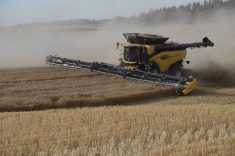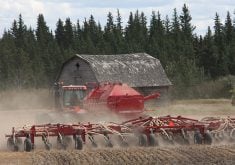The Winnipeg futures market can supply only one price for canola.
But hidden within that price, which was $431 per tonne for the November contract at close for Aug. 17, is a host of questions.
Two major questions that could swing prices dramatically one way or the other in coming weeks are:
- How big will the Canadian crop be?
- How much demand will appear to consume that crop?
Normally, they aren’t such big questions by this time of the season, but this hasn’t been a normal year on either the supply or demand sides.
Read Also

Input inflation shows need for more Canadian fertilizer
With grain prices much lower than in recent years and inputs high and in cases rising further, it will be difficult to fund farm operating costs this year, let alone fixed costs.
That means there’s no consensus on the new crop price outlook and the range in analysts’ opinions is huge.
“It ranges between $700 canola and $350 canola,” said Union Securities broker Ken Ball.
“It’s a tough one. No one’s confident trying to peg it down yet. There’s a wide degree of variability depending on which numbers you pick.”
For instance, some expect the Prairies to produce a crop of about 10.5 million tonnes. But frost within three weeks in a large area could drop that to nine million tonnes.
Analysts are projecting canola exports to be anything between five and seven million tonnes, a large range due to the fickleness of Chinese buying, which was large for 2008-09 but which in some years has disappeared.
Domestic crush is another area about which analysts are uneasy, with estimates ranging from 4.8 million tonnes to 6.1 million. New and expanded plants are coming on stream this crop year and much relies on how aggressive they are in buying market share, Ball said.
All these uncertainties mean that analysts are having trouble figuring out whether there will be adequate supplies of canola for the entire 2009-10 crop year.
“We could run out of crop by May or we could have a 900,000 tonne carryover by the end of the crop year,” said Ball with a laugh.
American analysts are also having a tough time wrestling with the question of demand for crops. Many economic analysts are saying that the recession appears to be ending and are projecting increased worldwide consumer demand for 2009-10, which should lead to increased consumption of crops.
The U.S. Department of Agriculture, in its August supply and demand report, boosted its expectation of crop consumption based on assumptions of better economic times coming, allowing market prices to remain steady after the report’s release. However, that worried analysts, who think increased consumer demand is not a safe assumption.
Joe Victor of Allendale Inc. said his company is projecting less corn use than the USDA and he questions its forecast.
“They are inflating demand based on an increased corn crop creating increased usage,” said Victor.
“I don’t see how you get that when the livestock feeding industry is shrinking.”
The canola market has broken many hearts this summer. Canola and other crop prices seemed to have finally caught the tails of the galloping equity markets and enjoyed a rise from late July into mid-August, reaching almost $450 on the November contract after the sub-$400 lows, but then the market turned.
Analyst and adviser John Duvenaud threw in the towel on his long canola positions on Aug. 17, as November canola fell back to $421.
“It should be going up but there’s a big crop of soybeans holding it down and I’ve just been wrong on it,” said Duvenaud.
“I think it’s a non-commodity thing. I used to think I understood these markets, but not anymore.”
With equity markets around the world tanking on Aug. 17 and dragging down commodities with them, that was a feeling shared by many trying to forecast future prices in an uncertain present.















